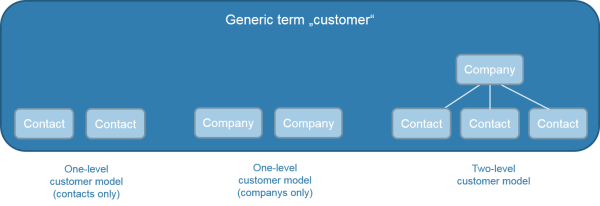Explanation of Terms
Customer
Customer is the generic term which designates the person or object that gave the reason for creating a ticket. The customer represents the external side of a ticket. A ticket always needs to have a customer as main customer. A customer always belongs to a customer group. Depending on the customer data model, a customer can either be:
- A company
The upper hierarchical level of a two-level customer model. A company can have several contacts. - A contact
The lower hierarchical level of a two-level customer model. A contact can only belong to one company.
The terms company and contact have the sole purpose of illustrating the hierarchical model. A company does not have to be a real company, and a contact does not have to be a real person. They could be machines, products, or any other entity managed in ConSol CM. It depends on the individual configuration of your CM system which entities are managed as companies and contacts.
Customer Data Model
The customer data model is the definition of the customer. There are two types of customer data models:
- One-level customer data model
Contains either companies or contacts, but not both of them. - Two-level customer data model
Contains companies on the upper hierarchical level and contacts on the lower hierarchical level.
The customer data model also determines the available data fields and possible relations. There can be several customer data models within one CM system.
Figure 81: Explanation of the terms: customer, company, and contact
Customer Group
The real customers, which are created using the Web Client, always belong to a customer group. The customer group determines which customer data model is used for its customers, i.e., which data fields are available and which relations and activities are possible for the customers. One CM system can have several customer groups to manage different kinds of customers within the same CM system. Engineers get access to customer data by customer group. They need at least read permissions for the customer group in order to see tickets whose main customer belongs to this customer group.
Each CM system uses customized customer groups and data models. Therefore, the available customer groups, hierarchical levels for customer objects, data fields, relations, and activities depend on the individual configuration of your CM system.
